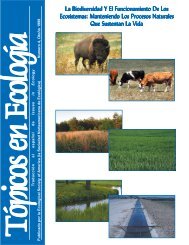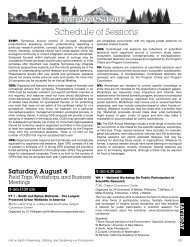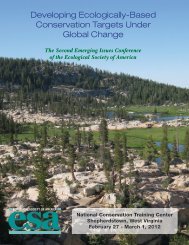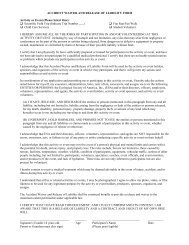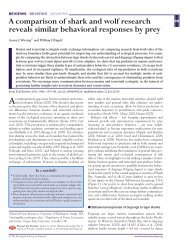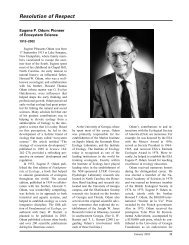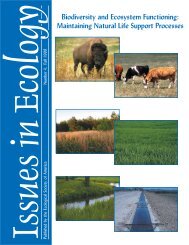Printed Program (PDF) - Ecological Society of America
Printed Program (PDF) - Ecological Society of America
Printed Program (PDF) - Ecological Society of America
You also want an ePaper? Increase the reach of your titles
YUMPU automatically turns print PDFs into web optimized ePapers that Google loves.
stage-dependence in shaping the selection gradients on<br />
senescence.<br />
2:30 PM OOS 47-4 Pringle, A, Harvard University. Life and death<br />
in a Petersham cemetery: The demography <strong>of</strong> potentially<br />
immortal organisms.<br />
2:50 PM OOS 47-5 Doak, DF, R Shriver and K Cutler, University<br />
<strong>of</strong> Wyoming. Looking for senescence in unorthodox<br />
organisms: A demographic life history analysis <strong>of</strong> an<br />
epiphytic lichen.<br />
3:10 PM Break<br />
3:20 PM OOS 47-6 Roach, D, University <strong>of</strong> Virginia. What<br />
patterns <strong>of</strong> aging emerge from a long-term, longitudinal,<br />
study <strong>of</strong> a plant population in the wild?.<br />
3:40 PM OOS 47-7 Jones, OR, R Salguero-Gómez, F Colchero<br />
and A Scheuerlein, Max Planck Institute for Demographic<br />
Research. On the variability <strong>of</strong> senescence trajectories.<br />
4:00 PM OOS 47-8 Garcia, MB1 , J Dahlgren2 and J Ehrlén2 ,<br />
(1)Pyrenean Institute <strong>of</strong> Ecology (CSIC), (2)Stockholm<br />
University. No senescence in a centenarian relict plant.<br />
4:20 PM OOS 47-9 Bronikowski, AM and FJ Janzen, Iowa State<br />
University. Senescence in ectothermic vertebrates:<br />
Peaks and valleys in the landscape <strong>of</strong> reptilian aging.<br />
4:40 PM OOS 47-10 Wensink, MJ and A Baudisch, Max Planck<br />
Institute for Demographic Research. If you want a long<br />
life, make sure to senesce.<br />
OOS 48 - Seedling-Herbivore Interactions: Insights Into<br />
Plant Defense and Regeneration Patterns<br />
A107, Oregon Convention Center<br />
Organized by: KE Barton (kbarton@hawaii.edu), M Hanley<br />
Moderator: KE Barton<br />
An examination <strong>of</strong> how seedling-herbivore interactions and seedling<br />
defense can shed new light on the evolution <strong>of</strong> plant defense and<br />
community ecology through a cross-synthesis <strong>of</strong> functional studies<br />
<strong>of</strong> plant defense and studies focusing the role <strong>of</strong> seedling herbivory<br />
in biodiversity, invasion biology, and regeneration.<br />
1:30 PM OOS 48-1 Orians, CM<br />
Life on Earth: Preserving, Utilizing, and Sustaining our Ecosystems<br />
1 , RS Fritz2 , CG Hochwender3 ,<br />
BR Albrectsen4 and ME Czesak2 , (1)Tufts University,<br />
(2)Vassar College, (3)University <strong>of</strong> Evansville, (4)Umea<br />
University. How slug herbivory <strong>of</strong> hybrid willows alters<br />
chemistry, growth, and susceptibility to diverse plant<br />
enemies.<br />
1:50 PM OOS 48-2 Hanley, M, University <strong>of</strong> Plymouth. Something<br />
in the air: Seedling volatiles and anti-herbivore defence.<br />
2:10 PM OOS 48-3 Queenborough, SA1 , MR Metz2 and R<br />
Valencia3 , (1)Ohio State University, (2)University <strong>of</strong><br />
California, Davis, (3)Pontificia Universidad Católica<br />
del Ecuador. Defense varies during leaf development<br />
in tropical seedlings, shedding light into herbivorymediated<br />
patterns <strong>of</strong> biodiversity.<br />
2:30 PM OOS 48-4 Barlow, SE, GR Port and AJ Close, Newcastle<br />
University. Interactions between seedling herbivory and life<br />
history traits affecting restoration <strong>of</strong> species-rich grasslands.<br />
2:50 PM OOS 48-5 Green, PT1 and KE Harms2 , (1)La Trobe<br />
University, (2)Louisiana State University. General<br />
3:10 PM<br />
hypotheses for why seedling dynamics are so important<br />
for determining patterns <strong>of</strong> abundance and diversity in<br />
plant communities.<br />
Break<br />
3:20 PM OOS 48-6 Lurie, MH and CC Daehler, University<br />
<strong>of</strong> Hawaii Manoa. Feeding preferences <strong>of</strong> generalist<br />
herbivores on invasive versus non-invasive seedlings in<br />
Hawaii.<br />
3:40 PM OOS 48-7 Maron, JL1 and D Pearson2 , (1)The University<br />
<strong>of</strong> Montana, (2)USDA Forest Service, Rocky Mountain<br />
1:30 pm-5 pm<br />
Research Station. Impacts <strong>of</strong> seed limitation, rodent<br />
seed predation, and disturbance on native and exotic<br />
seedling recruitment: Are there general patterns?.<br />
4:00 PM OOS 48-8 Zhao, J, Xishuangbanna Tropical Botanical<br />
Garden, Chinese Academy <strong>of</strong> Sciences. Interspecific<br />
variation in the rapid induced resistance and<br />
compensatory regrowth to herbivore in three Ficus<br />
saplings.<br />
4:20 PM OOS 48-9 Rubert-Nason, KF, KM Keefover-Ring and<br />
RL Lindroth, University <strong>of</strong> Wisconsin. Genotype and<br />
environment modulate the response <strong>of</strong> trembling aspen<br />
to simulated ungulate browsing.<br />
4:40 PM OOS 48-10 Kitajima, K, University <strong>of</strong> Florida. Cellulosebased<br />
toughness, but not silica- or phenolic-based<br />
defense, explains species differences in herbivory and<br />
leaf lifespan <strong>of</strong> tropical tree seedlings.<br />
OOS 49 - Why Do Birds Matter? Birds’ <strong>Ecological</strong><br />
Functions and Ecosystem Services.<br />
B110, Oregon Convention Center<br />
Organized by: DG Wenny (harrier2@mchsi.com), C Whelan, CH<br />
Sekercioglu<br />
Moderator: D Tomback<br />
The goal <strong>of</strong> this symposium is to bridge the gap between the current<br />
work in ecosystem services and the vast amount <strong>of</strong> data available on<br />
avian ecology that could inform the models on ecosystem services<br />
thereby fostering interdisciplinary collaborations for future work and<br />
promoting biodiversity conservation.<br />
1:30 PM OOS 49-1 Green, AJ, Estacion Biologica de Donana,<br />
CSIC. Seed dispersal by waterfowl.<br />
1:50 PM OOS 49-2 Wenny, DG, Loras College. Seed dispersal<br />
by terrestrial frugivorous birds.<br />
2:10 PM OOS 49-3 Rogers, HS1 , J Hille Ris Lambers2 , JJ<br />
Tewksbury2 and R Miller3 , (1)Rice University, (2)University<br />
<strong>of</strong> Washington, (3)University <strong>of</strong> Guam. The effect <strong>of</strong><br />
complete bird loss on the forests <strong>of</strong> Guam.<br />
2:30 PM OOS 49-4 Francis, CD1 , NJ Kleist2 , CP Ortega3 and<br />
A Cruz2 , (1)National Evolutionary Synthesis Center,<br />
(2)University <strong>of</strong> Colorado, (3)Fort Lewis College.<br />
2:50 PM<br />
Anthropogenic noise alters key ecological services<br />
provided by birds.<br />
OOS 49-5 Aslan, CE, ES Zavaleta, BR Tershy and DA<br />
Croll, University <strong>of</strong> California, Santa Cruz. Effectiveness<br />
<strong>of</strong> the non-native Japanese white-eye as a novel<br />
pollinator <strong>of</strong> endemic Hawaiian plants.<br />
3:10 PM Break<br />
3:20 PM OOS 49-6 Sekercioglu, CH, University <strong>of</strong> Utah.<br />
3:40 PM<br />
Conservation <strong>of</strong> bird functional diversity and ecosystem<br />
services in tropical forest, agr<strong>of</strong>orest, and agricultural<br />
ecosystems.<br />
OOS 49-7 Floyd, CH1 and K Martin2 , (1)University <strong>of</strong><br />
Wisconsin-Eau Claire, (2)University <strong>of</strong> British Columbia.<br />
Woodpeckers as ecosystem engineers.<br />
4:00 PM OOS 49-8 Seavy, NE1 , K McCune2 , A Merril3 , M<br />
Keever3 and J Guisse4 , (1)PRBO Conservation Science,<br />
(2)Sustainable Conservation, (3)Stillwater Science,<br />
(4)Xerces <strong>Society</strong> for Invertebrate Conservation.<br />
4:20 PM<br />
Incorporating birds into tools for measuring ecosystem<br />
services: A case study from Central California.<br />
OOS 49-9 Turner, WR, RM White, J MacFarland and<br />
ML Rosenzweig, University <strong>of</strong> Arizona. Reconciliation<br />
ecology in urban environments takes advantage <strong>of</strong> the<br />
popularity <strong>of</strong> birds.<br />
153<br />
THURSDAY



